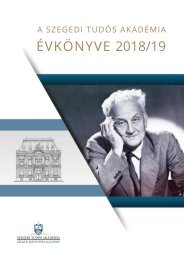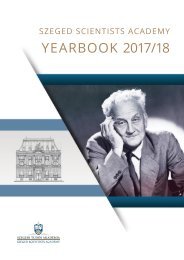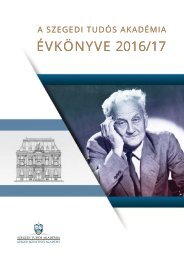SzSA YearBook 2016/17
Create successful ePaper yourself
Turn your PDF publications into a flip-book with our unique Google optimized e-Paper software.
SZENT-GYÖRGYI MENTORS<br />
LÁSZLÓ VÍGH<br />
Institute of Biochemistry,<br />
Biological Research Center of the<br />
Hungarian Academy of Sciences<br />
Address: Temesvári krt. 62., H-6726 Szeged, Hungary<br />
E: vigh.laszlo@brc.mta.hu<br />
T: +36 30/44 56 094<br />
RESEARCH AREA<br />
As a “central dogma” earlier it was suggested that stress-induced<br />
protein denaturation serves as a major stress-sensing<br />
machinery, which triggers the expression of the molecular<br />
chaperone heat shock proteins (HSPs). We have introduced<br />
a new but not exclusive cellular “membrane thermosensor”<br />
model, which predicts the existence of membrane-associated<br />
stress sensing and signaling mechanisms. It proposes<br />
that changes in the physical state and composition of lipid<br />
molecular species with the concomitant destabilization/<br />
reorganization of membrane microdomains (“rafts”) can<br />
serve also as “molecular switches” to operate “cellular thermometers”.<br />
Using mammalian cells and the fission yeast<br />
(S.pombe) as models we intend to elucidate the mechanism<br />
of membrane-associated stress sensors, signaling pathways<br />
and the interplay and networking of potential cellular stress<br />
survival strategies. Since HSPs play a fundamental role in<br />
the pathology of several human diseases, understanding<br />
the mechanism whereby mammalian cells can elicit a stress<br />
response may also be of paramount importance for the design<br />
of novel drug molecules.<br />
TECHNIQUES AVAILABLE IN THE LAB<br />
Classical biochemical and molecular biology methods.<br />
Membrane biophysics: spectroscopy, Langmuir monolayers,<br />
ultrasensitive fluorescence microscopy, single<br />
molecule tracking, image analysis. Lipidomic analysis:<br />
chromato graphic and mass spectrometry techniques. Multidimensional<br />
data analysis, statistical methods.<br />
SELECTED PUBLICATIONS<br />
Escribá, P.V., Busquets, X., Inokuchi, J.I., Balogh, G., Török, Z.,<br />
Horváth, I., Harwood, J.L., Vigh, L. (2015) Membrane lipid<br />
therapy: Modulation of the cell membrane composition<br />
and structure as a molecular base for drug discovery and<br />
new disease treatment. Prog Lipid Res 59: 38-53.<br />
Nagy, E., Balogi, Z., Gombos, I., Akerfelt, M., Björkbom, A.,<br />
Balogh, G., Török, Z., Maslyanko, A., Fiszer-Kierzkowska, A.,<br />
Lisowska, K., Slotte, P.J., Sistonen, L., Horváth, I., Vigh, L.<br />
(2007) Hyperfluidization-coupled membrane microdomain<br />
reorganization is linked to activation of the heat shock response<br />
in a murine melanoma cell line. Proc Natl Acad Sci<br />
USA 104: 7945-7950.<br />
Vigh, L., Horváth, I., Maresca, B., Harwood, J.L. (2007) Can<br />
the stress protein response be controlled by ‚membrane-lipid<br />
therapy’? Trends Biochem Sci 32: 357-363.<br />
Török, Z., Tsvetkova, N.M., Balogh, G., Horváth, I., Nagy, E.,<br />
Pénzes, Z., Hargitai, J., Bensaude, O., Csermely, P., Crowe,<br />
J.H., Maresca, B., Vigh, L. (2003) Heat shock protein coinducers<br />
with no effect on protein denaturation specifically modulate<br />
the membrane lipid phase. Proc Natl Acad Sci USA<br />
100: 3131-3136.<br />
Vigh, L., Literáti, P.N., Horváth, I., Török, Z., Balogh, G., Glatz,<br />
A., Kovács, E., Boros, I., Ferdinándy, P., Farkas, B., Jaszlits, L.,<br />
Jednákovits, A., Korányi, L., Maresca, B. (1997) Bimoclomol:<br />
a nontoxic, hydroxylamine derivative with stress protein-inducing<br />
activity and cytoprotective effects. Nature Medicine<br />
3: 1150-1154.<br />
75












